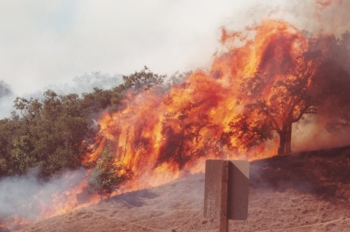Fire Safe Planting in Marin and Sonoma County
The short version of the story is this: There are very few plants that are “fire safe”. Most plants have some woody structure, and wood burns. There is such a thing as fire-safe landscaping.
Fire safe landscaping is primarily a function of how the landscape is designed, and how it is maintained. Plant species selection is a relatively minor component.
Click HERE for more information on Defensible space, fire safe landscaping, and fire hazard reduction.
Links: Fire Safe Marin Fire Safe Sonoma

There are a few plants that are “fire safe”. However, not everyone is willing to live in a landscape populated solely with Aloe vera, chard, and snapdragons. And even plants that we routinely think of as “fire safe” can burn if not cared for properly. Even iceplant.
In some instances, a “fire safe plant list” may give property owners a false sense of security. Homeowners who believe that their properties are “fire safe” due to the species they’ve selected may be less worried about maintaining their landscapes. Why worry, right? Every plant on the property is from a “fire safe” plant list!
Most of us are familiar with the coast live oak. The species is almost as associated with California as the redwood tree. Most fire-safe plant lists list coast live oak as fire safe. And yet a neglected coast live oak, with lots of interior deadwood and a canopy that grows all the way to the ground, can be a giant torch waiting to ignite. That same tree CAN be very fire safe if it has adequate access to water, has a canopy trimmed up off of the ground, and has few dead twigs in the canopy. Maintenance and design, not species selection, is the key.
For more information on designing fire-safe landscapes, please see Home Landscaping for Fire
Other helpful information:
Post Fire Restoration - "Do's and Dont's
Soil Quality Resource Concern-Hydrophobicity

